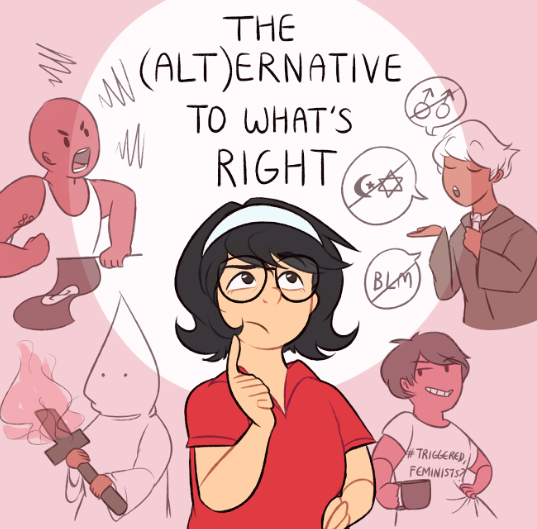The Alternative to What’s Right

December 12, 2016
Once the presidential election van finally sputtered to the finish line, Americans at the sidelines could only wonder what was in store for their country. While the majority of voters (by around 2.5 million as of the end of November) felt a dark four-year future ahead of them, the other side saw a tremendous victory for their beliefs – most notably, the members of the alt-right.
Alt-right stands for ‘alternative right’, referring to people with extreme right-winged ideology who reject mainstream conservatism. The term was coined by Richard B. Spencer, president of the National Policy Institute and founder of Alternative Right, a white supremacist website. Most archival data stem from the internet, notably 4chan and 8chan, where you can anonymously share all your grievances about ‘politically-correct’ liberals. Although their movement has no formal guidelines, most sources prioritize white nationalism as a necessary basis. Associated groups include men’s rights activists and anti-multiculturalists.
Do you see a pattern here?
These people are now entering the public with confidence, knowing their president will treat them kindly. This is further evidenced by Donald’s chosen chief strategist, Steve Bannon. A right-wing media mogul with a background in Harvard Business, Bannon is also the former head of Breitbart News. While the outlet was originally founded for “pro-freedom and pro-Israel” purposes, the corporation later aligned with alt-right beliefs under Bannon’s management, evidenced by their blunt scorn for Muslims, immigrants, and black activists. This spring, several top executives and journalists resigned, stating that “Breitbart’s unabashed embrace of Mr. Trump, particularly at the seeming expense of its own reporter, struck them as a betrayal of its mission.” Additionally, former employers accused Bannon of turning a website founded on “anti-authoritarian grounds” into a “de facto propaganda outlet for Trump.”
Notable examples of articles published during Bannon’s administration include:
- “An Establishment Conservative’s Guide to the Alt-Right”
- “Read the Scary Depictions of Refugees…”
- “Why Equality and Diversity Departments Should Only Hire Rich, Straight, White Men”
- “Would You Rather Your Child Have Feminism or Cancer?”
- “Hoisted High and Proud: The Confederate Flag Proclaims a Glorious Heritage”
Paralleling a racist uncle vehemently backing up his opinions by insisting that he isn’t racist, Breitbart has resisted the ‘white nationalist’ label and has made a statement declaring a “multi-million-dollar lawsuit against a major media company for its baseless and defamatory claim” of calling the website ‘white nationalist’.
This brings us back to the current alt-right movement. From the Washington’s Post’s “Let’s party like it’s 1933’: Inside the alt-right world of Richard Spencer”, the writer delves into the life of Spencer, the face of the alt-right movement who organized a conference of white nationalists a few weeks ago. The cover image shows a man in a black jacket, confidently gazing to the right as the faded Capitol building lays in the distance. In one section, Spencer listens to a video taken at Michigan, where hundreds of students chanted “No alt-right! No KKK! No racist USA!” – he plays it again with glee. “We’re getting under their skin,” he said. “I take a sadistic pleasure in that.”
“Let’s party like it’s 1933” is one of many articles from prominent news sources trying to discover more about the alt-right. With that, come issues. For one, the movement only grows stronger as more media coverage interprets them as people with just ‘different opinions’ and ‘alternative ideologies’. Preferring chocolate over vanilla is a debate of different opinions; believing innocent people don’t deserve rights is bigotry with destructive consequences.
Additionally, their ideas are treated as legitimate topics to cover. While alt-right leaders were talking with anchors on CNN, one of headlines read, “Alt Right Founder Questions If Jews Are People”. Call me just another stubborn liberal, but I am sickened by such narrow-minded ideas being broadcasted on mainstream television. Why is the idea of a group of already marginalized people deserving to live even a talking point? How do these people have a public platform, in a time where people of color, immigrants, women, and the LGBT community already fear for their future?
Everyone is human, I get it. Judging someone solely on their political beliefs can be counterproductive, and sometimes you need to look at the other side to see where they’re coming from.
But if the election results have proved anything, it’s that racism is making a resurgence through normalization. By airing discussions over which groups deserve human rights, American people are suddenly being told that having racist beliefs is just another side in a ‘complex’ debate. You wouldn’t see a fascist skinhead discussing with major news anchors why he doesn’t see Jews as human, so a wealthy white guy in a suit with the same opinions should be treated as just as wrong. Just because these people don’t fit the stereotypical image of hateful bigot, doesn’t make their views, as well as their actions and influence, any less dangerous.
This extreme conservatism campaign is turning into a trendy movement where bigotry can hide. There are klansmen without hoods, neo-nazis without swastika neck tattoos, and xenophobic nationalists with tidy outfits and a quirky personalities. Let’s drop the palatable, seemingly-innocuous term ‘alt-right’ and call them what they really are – nazis and white supremacists.






